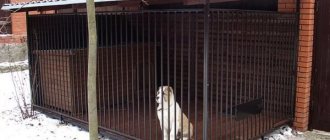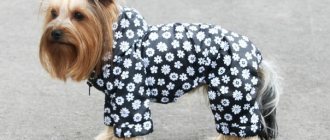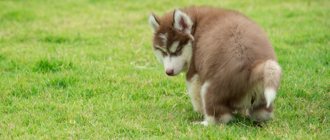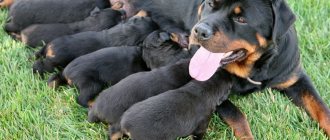At the training site of the Moscow Fire and Rescue Center there are models of a car damaged in an accident, a van with a blocked entrance, imitation of the rubble of a destroyed house and other natural sites that help simulate the actions of employees in emergency situations. Not only people train here, but also their irreplaceable assistants - rescue dogs.
The emergency rescue squad No. 6 of the Fire and Rescue Center employs seven dog handlers and the same number of dogs . The four-legged animals are specially trained to search for people during collapses and in forested areas. The canine team goes on duty every day at the training ground in Aparinki.
The squad includes fighters of various breeds and sizes: Labrador, Border Collie, Fox Terrier, Australian Heeler, Bavarian Hound, White Swiss Shepherd and Hungarian Cattle Dog. All of them are the dog handlers’ personal pets. They come from home to work together with their owners, but they need to train, practicing rescue skills or regular commands, every day.
Dog professions and specializations
In peacetime, service dogs have become indispensable assistants to people at customs, borders, and in security and rescue services.
There are more than twenty canine professions and specializations that pets can do better than humans.
- Guides.
- "Therapists" . These dogs work in rehabilitation centers for children with autism, other congenital developmental abnormalities, or suffering from mental disorders.
- Rescuers . Thanks to their keen sense of smell, dogs find victims under meters of snow, collapsed buildings, in mountains, deserts, forests and under water.
- Shepherds . Representatives of certain breeds help shepherds and shepherds monitor the herd, find lost and lagging animals, and protect them from attacks by bloodthirsty predators.
- Hunters . Hunting dogs become reliable assistants, capable of scenting and tracking prey over several kilometers. But even for those people who have chosen hunting as entertainment, it is difficult to imagine it without a faithful friend.
- Security guards . Specially trained dogs are trusted to protect public and private facilities, as well as people’s lives.
- Water rescuers . Most often, Newfoundlands are used for this purpose, capable of swimming over 30 km, diving to a depth of 20 m, jumping into the water from a pier, the side of a ship and even a helicopter, and pulling people and small boats ashore.
- Dogs capable of finding drugs, explosives and objects.
- Policemen . The duties of the four-legged animals include tracking down the criminal, freeing hostages, searching for material evidence and missing people.
- Military . Such dogs find and carry out wounded soldiers, transmit reports and mail in places where there is no communication, detect mines and tripwires, and bring ammunition.
It is worth noting that in some countries, dog sleds remain the only possible means of transportation in conditions of deep snow and extreme cold.
Interesting fact! The Lagotto Romagnolo is a unique breed of dog with a keen sense of smell, bred specifically to search for truffles. They are able to find these expensive mushrooms at a depth of 60 cm, dig them up on their own and give them to their owners.
What do dogs do in the Ministry of Emergency Situations?
Various breeds serve in the structure of the Ministry of Emergency Situations, all of them are divided into groups, each of which has its own purpose in emergency rescue operations. Four-legged rescuers are divided into the following specializations:
- work to search for survivors and wounded people when examining the rubble;
- mountain avalanche search work;
- mine detection work. Animals are mainly used for preventive measures (to study a large area with a large number of people). Some breeds are specially trained for clearing areas after military operations;
- water rescue;
- search for bodies of seriously wounded and dead;
- rescue work by smell searching for people;
- security service for government buildings and guard patrols.
Only with proper upbringing and regular training do dogs develop the skills they need to be a rescuer. If mistakes were made during training in puppyhood, it is extremely difficult to correct them later.
TOP 3 water rescue dogs
The TOP 3 water rescue dogs include the following breeds:
- Newfoundland;
- Labrador;
- Leonberger.
Newfoundland
Representatives of the Newfoundland breed are always associated with saving drowning people, and this opinion is completely justified. The fact is that these dogs have a genetically highly developed need to bring all floating objects to the shore.
The breed's homeland is considered to be the northeastern coast of Canada, where ships from various countries waited out the storm in quiet bays. According to one version of the researchers, Newfoundlands were bred by crossing ship dogs brought on these ships with local dogs.
Newfoundlands are distinguished by endurance, friendliness towards other animals and humans, and a developed mind. They are excellent defenders of their owners, but they never attack first.
Features that make them the best water rescuers include:
- water-repellent undercoat, allowing you to stay in cold water for a long time;
- the presence of skin membranes between the phalanges of the fingers, increasing the speed of advancement;
- the special structure of the ears and eyes, which makes it possible to go deep under water.
It is also worth noting the high reaction speed, thanks to which dogs quickly notice people in trouble and rush to their aid.
Labrador
Labrador Retrievers are excellent swimmers. Previously, they helped fishermen pull out nets with their catch. But, starting from the second half of the twentieth century, they began to be taken for hunting, used as guides for blind people, as well as “caring nannies” for children.
However, many instructors continue to teach their pets the rules of helping drowning people, and now Labradors are responsible for saving thousands of lives.
Leonberger
This dog breed was developed in Germany by crossing a Pyrenean mountain dog with a Newfoundland. She is distinguished by strength, calmness and endurance.
Leonbergs were used for transporting goods on land, as well as towing small boats on the water; they guarded herds and human dwellings, and thanks to their heightened sense of smell, they followed the trail of missing people in forests and mountains.
Until the beginning of the twenty-first century, this breed was little known outside of Germany, France and the Netherlands. However, now it has become more widespread, and security guards are used in many countries in Europe, Russia and America.
Newfoundlands are excellent swimmers, endowed with the instinct to bring various floating objects to shore, as well as provide assistance to drowning people. That's why they have proven themselves to be excellent water rescuers.
It is known, for example, that during Napoleon's escape from the island of Elba, he fell into the sea and was saved by the ship's Newfoundland dog. Bob's Newfoundland has drowned many people in the UK, for which he was awarded a gold medal. In 1919, during a storm, the ship "Et" ran aground and was in distress. The captain sent a sailor ashore to report what had happened, but he was unable to swim and drowned. The last hope was the Newfoundland Tang. The dog swam to the shore, and the people in distress, including an infant, were saved.
In Väino Bay (Estonia), the Newfoundland Lados Bay (owner M. Mägi), trained to help people on the water, saved a 16-year-old girl. The wind carried her, unable to swim, on a rubber mattress into the open sea. Attempts to catch up with the girl and help her were unsuccessful. Then Lados Bey was sent by the “Save” team, and he did an excellent job with his important task.
Newfoundlands have long been used to carry various heavy loads. An engraving by Philip Rangely (1740-1833) shows a black and white Newfoundland pulling a loaded sleigh in the foreground among a group of other dogs. In 1837, a decree was issued in London prohibiting the use of dogs for transporting goods.
Newfoundlands were also used as guard dogs. And although this type of service is secondary for Newfoundlands, it should be borne in mind that, if necessary, despite its friendliness, the Newfoundland will offend its owner.
In our country, the first experiments on the use of Newfoundlands in water rescue services were carried out in the summer of 1975 in Estonia by the Water Rescue Society (OSVOD). In 1976, an experimental group of Newfoundland dogs was created, with which work was carried out using a specially developed methodology. Around the same time, similar work began in Leningrad and somewhat later in Norilsk and the Latvian SSR.
The main activity on the use of rescue dogs in Tallinn is carried out by the section of Newfoundland dog owners of the Estonian Republican Service Dog Club DOSAAF with the active participation of the Tallinn City OSVOD.
The city committees of DOSAAF and OSVOD approve and support all the section’s initiatives aimed at developing water rescue services using dogs. At the Tallinn rescue station OSVOD, the section built a small pier for three-four-seater boats, and a shed for storing sails and other property. A special sports and training ground has been equipped on the banks of the Pirita River. All this serves as the basis for conducting the necessary educational and training sessions with dog owners and their four-legged helpers.
The preparation of puppies, future rescuers of people on the water, begins with educational training, carried out according to the generally accepted method for all service dogs. Once the puppies reach 4-6 months of age, they are given classes in initial (preliminary) general puppy training. At the same time, we conduct short-term, usually monthly, training sessions twice a week for dog owners on the basics of keeping, raising, and training dogs.
One-year-old dogs are trained according to a general training course, according to the generally accepted DOSAAF methodology, but taking into account the purpose of dogs for water rescue service. Additionally, animals are trained to enter a boat and swim in it, and swim behind the boat up to 500 m.
Having mastered OKD, they begin special training of dogs. At the same time, their owners are trained in the methods and techniques of special training and, in addition, methods of providing assistance to drowning people: artificial respiration, massage, dressing wounds, assistance with fractures, bruises, etc. During this period, special attention is paid to developing the dogs’ skills to swim behind a boat up to 1000 m, find and carry out transportation items on the water, tow drowning people to the shore, etc.
When starting to train Newfoundlands, you need to know that the opinion that existed among dog breeders that Newfoundlands are stupid dogs and can only be trained from the age of two is wrong. Animals of this breed are perfectly trained; you just need to have good contact with them and structure each lesson correctly, taking into account their previous preparedness and individual characteristics. We must strive to observe the principle of gradually introducing complications, not to overload the dogs, and always monitor their general condition. You need to learn to “read” a dog’s mood in its eyes. As soon as you notice indifference, “boredom” in them, you need to stop training, provide the dog with active rest (a short walk in a free state for the dog) and then continue training. You should not give commands, including repeated ones, too loudly or rudely. This does not help, but rather harms the training process. Moreover, this is unacceptable when performing patrol duty on the shore, in the presence of vacationers.
In our section, general training of dogs, as mentioned above, usually begins when they reach one year of age, and by two years the animal is completely ready for rescue service.
In the initial, educational training of puppies and young dogs - future water rescuers, special attention is paid to teaching them to swim, first near the shore, and then behind the boat. At first, swimming behind the boat is limited to 50-100 m and gradually increased to 1 km.
Special training also includes teaching the dog to calmly enter swimming facilities, sit, lie down, stand on them, swim and go ashore on command.
It is recommended to teach your dog these skills as follows. The trainer with the dog at his left leg makes a guiding gesture with his right hand and, at the same time giving the command “Forward” with his voice, directs the dog onto a boat or other watercraft and enters after it. On command “Sit”, “Lie down”, “Stand” forces the dog to take the appropriate place and position, which can periodically change on command. The dog must calmly, without leaving its place, swim on the watercraft and, upon the command “Forward” and a gesture, go ashore.
Teaching a dog to fetch in water is done by giving the command “Fetch” by voice and gesturing with the right hand in the direction of the thrown object with a slight tilt of the body forward. Classes are conducted without equipment.
The trainer with the dog at his left leg approaches the shore, sits him down, throws the fetching object into the water (initially near the shore, gradually further) and with the command “Fetch”, he sends the dog after the object with a gesture. The dog must swim to the object, float it to the shore to a depth when the animal’s paws reach the bottom. There is no need to take objects ashore, since when rescuing drowning people, the dog must deliver them through the water to the shore to a shallow place.
At the next stage of special training, the future rescue dog is taught to swim behind the boat. This is done by giving the voice command “Forward”, with a guiding gesture with a slight tilt of the body forward if the dog is sent after the boat by an assistant, or “Come to me” if the dog is called to the boat by the trainer sailing on it. When the dog is swimming behind the boat, you need to balance the speed of the boat with the physical capabilities and swimming experience of the dog. The dog's swimming distance increases gradually and is increased to 500 m.
All techniques are practiced without a leash, with the exception of the techniques “Prohibition of taking food scattered on the ground and given by a stranger” and “Stopping unwanted actions.” Here, at first, a short leash is used. For correct execution of commands (gestures), dogs are rewarded with the exclamation “Good” and a treat (the latter is used less often in sufficiently trained dogs).
to Home Page
For questions about posting articles, please contact
TOP 3 rescue dogs in the mountains
Instructors claim that almost any dog that meets the following requirements can be trained to rescue:
- strong constitution;
- well-developed muscles;
- endurance;
- ability to withstand high psycho-emotional stress;
- ability to adapt to changing climatic conditions;
- well developed sense organs;
- lack of aggression towards a person and the desire to come to his aid;
- the ability to make independent decisions in extreme situations;
- good ability to learn commands.
This is due to increased requirements for dogs helping mountain rescuers, who must be able to:
- quickly find and bark to identify missing people;
- escort members of the rescue expedition to the scene of the incident;
- carry special clothes, belongings of victims or pull small carts;
- concentrate on the subject of search, without being distracted by extraneous stimuli;
- unquestioningly carry out all commands given by the instructor.
The TOP 3 rescue dogs in the mountains include:
- Saint Bernards;
- German Shepherds;
- Alaskan Malamutes.
Saint Bernard
This breed was bred by the monks of the monastery of St. Bernard, located in the Swiss Alps. The original purpose of these dogs was to protect the inhabitants and guests from enemies and wild animals. But, starting from the 18th century, they had to change their type of activity due to changes in climatic conditions in the Alps and frequent avalanches. Saint Bernards easily found people under a multi-meter layer of snow and warmed them with their warmth until help arrived.
Currently, along with excellent physical characteristics, a calm, balanced character and developed intelligence, representatives of this breed have retained the unique ability to masterfully navigate unfamiliar terrain and always find their way back home.
German Shepherd
Possessing a strong character, well-developed muscles, endurance, a good sense of smell and the ability to get along with people, German Shepherds are almost universal dogs used for guarding objects, searching and rescuing people, at customs, airports, border and police units.
They often participate in search operations for climbers under snow debris. These strong dogs are capable of not only independently finding and digging out a person from under the rubble, but also dragging him for a certain time to a safe place.
Alaskan Malamute
Since ancient times, representatives of this breed have been used by Alaskans for sled riding and cargo transportation.
Note! Alaskan Malamutes participated in the conquest of the North and South Poles. They survived themselves and saved the lives of their owners in extremely harsh permafrost conditions. Even falling through the ice, they survived thanks to their waterproof undercoat and colossal endurance.
A particularly valuable quality of Malamutes is their love of digging deep holes. Thanks to it, a dog can free an injured person from under the rubble in a matter of minutes, and then transport him to the place of assistance.
What breeds of dogs serve in the Ministry of Emergency Situations
There are no restrictions on dog breeds for rescue missions. Dogs of any breed that have passed certification can participate in saving people. Not only shepherd dogs and Labradors, but also hunting dogs, different types of terriers, pit bulls, even dachshunds and spitz dogs work in the rescue service. There are several qualifications for dogs.
Search dog specializations:
- search and rescue;
- mountain avalanche;
- water rescue;
- searching for those who are no longer alive;
- search service;
- mine clearance service.
The choice of dogs for service in the Ministry of Emergency Situations does not depend on their pedigree. Dog handlers value in their pets the ability to find a way out of a situation and make decisions independently in emergency situations. Some breeds find it easier to navigate in the forest, while others find it easier to work on rough terrain and in the mountains. But even a well-physically trained dog will not be able to work in mountain conditions without special training.
According to rescue workers, dogs with a height of 45-65 cm are more suitable for searching for people buried under the rubble of a collapsed building. Their weight should not exceed 60 kg. It is difficult for a large pet to move in places with rubble, and a small dog feels uncomfortable in the forest.
Based on their service qualities, the first place among search and rescue dogs is occupied by collies. They can be used in all types of searches, they are not aggressive towards strangers, and are gentle with children. One can only envy their intelligence and ability to work independently at a distance from the dog handler.
Rescue dog during training
Laikas proved themselves well during hostilities as assistant orderlies; they were used to pull the wounded out of the battlefield. They are still successfully used in the northern regions. They have no equal in terms of endurance.
Many rescue workers prefer Labradors for their unique working qualities and light weight. They can be easily carried by hand if necessary. They are brave, move easily on narrow surfaces, and quickly find people.
Dog breeds for emergency services
The most famous and sought after breed of dog for emergency services is the German Shepherd. It is used to search for explosives, drugs, missing people, and criminals.
The most valuable property is the rapid adaptation to the new owner and the precise execution of his commands. This quality is necessary in police service, when there is a frequent change of employees.
There are also other popular breeds.
- Dobermans. They are more often used for security than in the police or customs, since they obey one owner and do not accept the commands of other people.
- Rottweilers. Used as a bodyguard, to protect objects and search for people. Cannot tolerate a change of owner.
- Bullmastiffs. They are mainly used in security services, but due to their heightened sense of smell they are used to search for drugs, explosives and people under rubble.
- Boxers. Excellent guards, distinguished by courage, strength and intelligence.
- Pit bull terriers. Insensitive to pain, unquestioningly obeying the commands of the owner, for whom they would not hesitate to give their lives, these dogs are ideal for guarding people and objects.
Stories of the most famous rescue dogs
People have long created legends about canine fidelity and devotion. Every four-legged pet, regardless of size, is ready to protect its beloved owner until the last breath. But there are some pets whose names have gone down in history forever, since they are responsible for saving hundreds of human lives.
Among the stories of the most famous rescue dogs, it is worth highlighting the St. Bernard Barry, the shepherd Ajax, the Swansea Jack retriever, and the Newfoundland Tang.
- St. Bernard Barry saved more than 40 people during his life, freeing them from captivity in the snow. Among them was a little boy, whom a dog carried on his back to a monastery located in the mountains.
- The shepherd dog Ajax saved people from under the snow for four days. By the end of the rescue operation, her paws were worn down to the bone, but she did not leave her post until the last person was rescued.
- The Swansea Jack retriever saved more than 27 drowning people, for which he was awarded many awards. A monument was erected in his honor in England.
- Newfoundland Tan saved the lives of 93 sailors by towing a ship that was sinking during a storm into the harbor.
This is interesting! In 1945, an unprecedented case occurred when a dog named Dzhulbars was awarded the medal “For Military Merit.”
This honor was given to the dog who discovered more than seven thousand mines and one hundred and fifty unexploded shells during the Second World War. The wounded Dzhulbars was carried on Stalin's jacket across Red Square during the Victory Parade.











